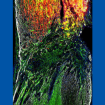New award advances Sanders-Brown director’s research on inflammation’s role in Alzheimer’s

The University of Kentucky Sanders-Brown Center on Aging Director Linda Van Eldik, Ph.D., hopes to shed light on how specific brain cells may contribute to the progression of Alzheimer’s disease, paving the way for potential new therapeutic approaches.
Van Eldik recently received a three-year, $300,000 award from the BrightFocus Foundation to support her research project, “Relationship between astrocyte p38 MAPK, neuroinflammation, and Alzheimer pathology.”
Alzheimer’s disease, a progressive brain disorder, leads to memory loss and cognitive decline. While its exact cause remains elusive, scientists know that chronic inflammation in the brain plays a role in its development.
Inflammation is typically associated with immune cells called microglia, but recent studies suggest that astrocytes — another type of brain cell — also significantly contribute to brain health and disease. Astrocytes are the most abundant cell type in the brain and are responsible for supporting nerve cells, maintaining the blood-brain barrier and regulating blood flow.
Van Eldik’s project will focus on p38 MAPK, a protein which plays a key role in driving inflammation in the brain. Although its role in microglia has been extensively studied, p38’s function in astrocytes is not as well understood.
“We know that p38 is involved in inflammation in Alzheimer’s, but we still need to learn more about how this process works specifically in astrocytes,” Van Eldik said. She is seeking to uncover how p38 activation in astrocytes might link to inflammation and subsequent nerve cell damage in Alzheimer’s disease.
The project will use advanced techniques to investigate how astrocyte-related inflammation may contribute to Alzheimer’s. The team’s central hypothesis suggests that activation of p38 in astrocytes might trigger the release of a molecule called IL-33, which could then promote further inflammation and nerve cell damage.
The research will follow two main objectives: first, to explore how p38 and IL-33 influence inflammation and nerve cell damage in mice under conditions that mimic an inflammatory response; second, to study samples from individuals with varying degrees of Alzheimer’s pathology to identify connections between activated p38, reactive astrocytes and cognitive impairment.
Van Eldik firmly believes this research could help identify new targets for therapeutic intervention in Alzheimer’s disease. “Understanding these cellular processes can guide us toward more precise treatments aimed at reducing harmful brain inflammation, hopefully slowing the progression of the disease,” she said.
The BrightFocus Foundation award not only recognizes the promise of Van Eldik’s work but also underscores the importance of investigating underexplored mechanisms in Alzheimer’s research. The Sanders-Brown Center on Aging remains committed to advancing the understanding of neurodegenerative diseases and translating discoveries into meaningful outcomes for patients and families affected by Alzheimer’s.
Acknowledgement is made to the donors of Alzheimer’s Disease Research, a program of BrightFocus Foundation, for support of this research.





